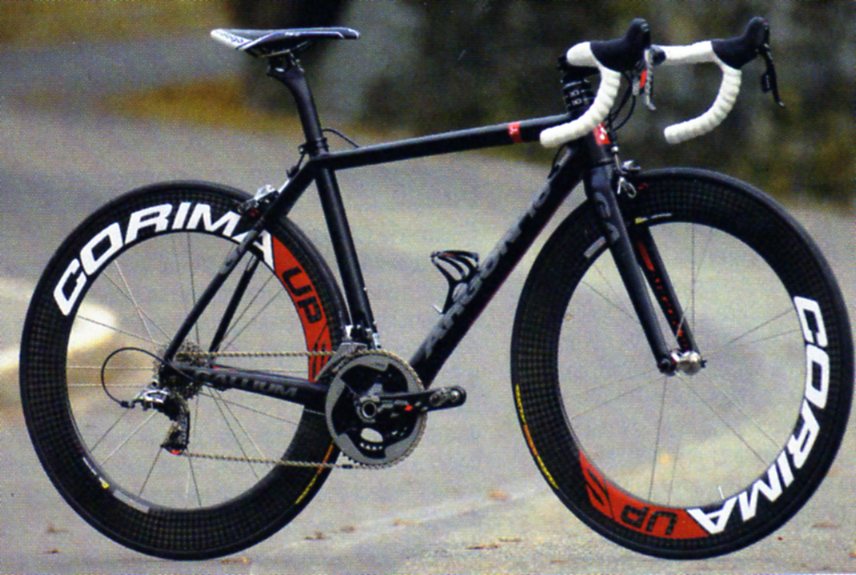Interbike 2012: Racing Drivetrains
Another big theme of my one-day Interbike experiene was drivetrains. First, shifting...
Shimano had a big booth and supposedly they showed a new electronic shifting system. I missed that as, I admit, I am no Shimano fan and didn't spend much time there. I did try the new Dura-Ace 9000 shifters and these had a very nice shifting action. But then all the big three have a very nice shifting action.
At the Campagnolo booth my focus was on their EPS electronic shifting system. They had the system set up on a Pinarello bike on a trainer. In retrospect I regret not having tried out their mechanical shifters as well, but Vegas-and-back in a day makes for a tiring day and I wasn't 100%. In any case, the EPS shifting nicely on the test bike, and I had no problem adapting to their shifter location. However, it seemed a bit artificial to me, designed for hands familiar with their mechanical shifting rather than optimized specificially for the electronic shifters.
Again, I was negligent at the SRAM booth, but I don't recall there being any shifting demos there. I'd like to have known how the 2012 Red system shifts. In fairness, the real place for these tests would have been the outdoor demo, which I missed.
The big deal at the SRAM booth was the X1 wide-range mountain bike group. The name is clever, since the "1" in X1 seems like it refers to the single chainring, but taking X to represent the Roman numeral for 10, it refers to the 11 cogs in the back. SRAM has had a brilliant debut with the system, which wasn't targeted at cross-country racing where speed and efficiency is the top priority. But then their system was used in winning the World Championship cross-country race. All you need to do is look at how well single speed mountain bikes do in races compared to bikes with 27 or 30 gears to realize gear selection in mountain bike racing is easily overvalued. Sure, one speed is non-optimal, but having 11 useful gears, evenly spaced, may well be close to the saturation point. In road riding, there's long periods riding along on smooth roads of relatively consistent grade, with plenty of time to settle into an finely tuned cadence. Mountain biking is tends to be a lot different, however, with conditions changing constantly, the bike bouncing around so much that optimized cadence tends to be far down the list of concerns, position on the bike changing frequently due to changing trail conditions. Shifting less is more of a priority, shifting to constantly stay at a narrowly optimized cadence less so. So 1x11 may well make a lot of sense. Front shifts are eliminated, and with them a lot of problems front derailleurs present, including a welcome if small reduction in mass. And since the rear derailleur no longer needs to take up the rapid changes in tension associated with changes of in excess of ten teeth on the chainring, it can be optimized for rear shifting. The SRAM 1x11 isn't simply a conventional system with a single front ring: the entire system is optimized for 1x11. This is why I love SRAM: they take a fresh look at every aspect.
The SRAM cassette was truly a beautiful thing: they had a cut-away version so the interior could be adequately admired:

SRAM X1 cassette: very cool!
The other things at the SRAM booth were the "WiFi" long-cage Red derailleur and the Quarq power meter. For the derailleur, I don't expect it's that much better than the Rival one which has been available: ceramic bearings in the pulleys and slightly lower mass. The bigger deal is the acceptance of long-cage (or perhaps more correctly "medium-cage") derailleurs at the highest level. There's been a lot of inertia in the acceptance of lower gears, based on an aesthetic from the days of 5-speed freewheels. But as old generations die off and new generations emerge, people realize the enormous performance advantages of using low gears on steep climbs, and as a result roads which had previously been considered impractical for anything other than rare masochistic suffer-fests become roads where speed, rather than simple survival, become the priority.
I took a photo of Peter Sagan's green jersey bike in the booth. Curious feature here is the bike had a competitor's (SRM) spider-based power meter, no Quarq. I was wondering why that had been until I noticed whose bike it was. No WiFi there! Next to it was Levi Leipheimer's Trek with WiFi Red and the Quarq/SRAM power meter. At the time I found it less interesting and neglected to take a photo.

Peter Sagan's green jersey bike: no WiFi here!


Comments